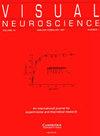Imaging the adult zebrafish cone mosaic using optical coherence tomography
IF 1.1
4区 医学
Q4 NEUROSCIENCES
引用次数: 15
Abstract
Abstract Zebrafish (Danio rerio) provide many advantages as a model organism for studying ocular disease and development, and there is great interest in the ability to non-invasively assess their photoreceptor mosaic. Despite recent applications of scanning light ophthalmoscopy, fundus photography, and gonioscopy to in vivo imaging of the adult zebrafish eye, current techniques either lack accurate scaling information (limiting quantitative analyses) or require euthanizing the fish (precluding longitudinal analyses). Here we describe improved methods for imaging the adult zebrafish retina using spectral domain optical coherence tomography (OCT). Transgenic fli1:eGFP zebrafish were imaged using the Bioptigen Envisu R2200 broadband source OCT with a 12-mm telecentric probe to measure axial length and a mouse retina probe to acquire retinal volume scans subtending 1.2 × 1.2 mm nominally. En face summed volume projections were generated from the volume scans using custom software that allows the user to create contours tailored to specific retinal layer(s) of interest. Following imaging, the eyes were dissected for ex vivo fluorescence microscopy, and measurements of blood vessel branch points were compared to those made from the en face OCT images to determine the OCT lateral scale as a function of axial length. Using this scaling model, we imaged the photoreceptor layer of five wild-type zebrafish and quantified the density and packing geometry of the UV cone submosaic. Our in vivo cone density measurements agreed with measurements from previously published histology values. The method presented here allows accurate, quantitative assessment of cone structure in vivo and will be useful for longitudinal studies of the zebrafish cone mosaics.光学相干断层成像成年斑马鱼锥体马赛克
摘要:斑马鱼(Danio rerio)作为研究眼部疾病和发育的模式生物具有许多优势,其光感受器镶嵌的无创评估能力引起了人们的极大兴趣。尽管最近应用了扫描光眼底镜、眼底摄影和角镜来对成年斑马鱼的眼睛进行体内成像,但目前的技术要么缺乏准确的缩放信息(限制了定量分析),要么需要对鱼实施安乐死(排除了纵向分析)。在这里,我们描述了使用光谱域光学相干断层扫描(OCT)成像成年斑马鱼视网膜的改进方法。使用Bioptigen Envisu R2200宽带源OCT对转基因fl1:eGFP斑马鱼进行成像,使用12mm远心探针测量轴向长度,使用小鼠视网膜探针获得名义上1.2 × 1.2 mm的视网膜体积扫描。面部总体积投影是使用定制软件从体积扫描中生成的,该软件允许用户根据感兴趣的特定视网膜层创建量身定制的轮廓。成像后,解剖眼睛进行离体荧光显微镜检查,并将血管分支点的测量值与正面OCT图像的测量值进行比较,以确定OCT横向尺度作为轴向长度的函数。利用该缩放模型对5种野生斑马鱼的感光层进行了成像,并量化了UV锥亚马赛克的密度和堆积几何形状。我们的体内锥体密度测量结果与先前发表的组织学值测量结果一致。本文提出的方法允许对体内锥体结构进行准确、定量的评估,并将对斑马鱼锥体镶嵌的纵向研究有用。
本文章由计算机程序翻译,如有差异,请以英文原文为准。
求助全文
约1分钟内获得全文
求助全文
来源期刊

Visual Neuroscience
医学-神经科学
CiteScore
2.20
自引率
5.30%
发文量
8
审稿时长
>12 weeks
期刊介绍:
Visual Neuroscience is an international journal devoted to the publication of experimental and theoretical research on biological mechanisms of vision. A major goal of publication is to bring together in one journal a broad range of studies that reflect the diversity and originality of all aspects of neuroscience research relating to the visual system. Contributions may address molecular, cellular or systems-level processes in either vertebrate or invertebrate species. The journal publishes work based on a wide range of technical approaches, including molecular genetics, anatomy, physiology, psychophysics and imaging, and utilizing comparative, developmental, theoretical or computational approaches to understand the biology of vision and visuo-motor control. The journal also publishes research seeking to understand disorders of the visual system and strategies for restoring vision. Studies based exclusively on clinical, psychophysiological or behavioral data are welcomed, provided that they address questions concerning neural mechanisms of vision or provide insight into visual dysfunction.
 求助内容:
求助内容: 应助结果提醒方式:
应助结果提醒方式:


